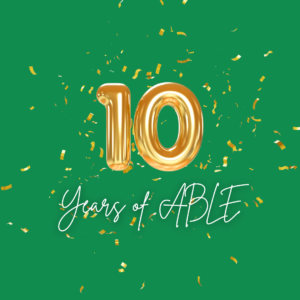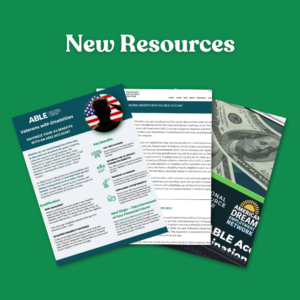 The Winter Issue of our AchievABLE Newsletter - 2024 ABLE Anniversary Edition contains stories on the following:
The Winter Issue of our AchievABLE Newsletter - 2024 ABLE Anniversary Edition contains stories on the following:
Happy 10th Year Anniversary to the ABLE Act!
December 2024 marks a decade that the ABLE Act has helped to build a better financial future for people with disabilities. We pay homage to a group of parents, including Stephen Beck Jr., who sat around a kitchen table nearly 15 years ago as they conceptualized a more stable economic future for their children with disabilities. As a result of this grassroots discussion, Congressional Champions including Sens. Robert Casey, Jr. (D-PA) and Richard Burr (R-NC), and Representatives Ander Crenshaw (R-FL), Chris Van Hollen (D-MD), Cathy McMorris Rodgers (R-WA) and Pete Sessions (R-TX), sponsored the ABLE Act as part of the Tax Increase Prevention Act of 2014. President Obama signed this act into law on December 19, 2014. The ABLE Act has been moving the needle of financial stability for people with disabilities and their families forward ever since.
State and national ABLE plans have been created, totaling 49 plans. Additional legislative efforts have been made throughout the years lessening requirements, enhancing access for more people with disabilities, sponsoring tax reform to assist people with disabilities to save and protecting these measures to remain in place for many years to come.
Today, more than 187,000 accounts are open nationwide with more than $2 billion assets under management. Account owners can save up to the state plan’s limit, which in many cases is over $500,000. ABLE plans have allowed people with disabilities to accumulate assets well above the $2,000 resource limit. Despite these gains, there is still work to be done to support a stronger economic future for people with disabilities. National Disability Institute (NDI) and the ABLE NRC support efforts that will protect current provisions in the ABLE Act that are scheduled to sunset at the end of 2025, expand eligibility, reduce barriers and add flexibility to enrollment and account management to allow more individuals and their families to experience the power of ABLE.
As we celebrate this milestone, we are reminded of the journey behind each ABLE account opened and the growing impact the ABLE Act continues to have on individuals and families nationwide. This decade has shown us what is possible when people unite behind a common vision for financial empowerment and inclusion. Together, we look forward to new advancements and will continue to work towards a future where every individual with a disability can achieve financial independence and security. Here’s to the next decade of progress and the powerful legacy that ABLE has built and will continue to grow.
Read the full history of the ABLE Act compiled by the ABLE National Resource Center (ablenrc.org).
able ambassador spotlight

Emily, an attorney and disability rights advocate, has dedicated her life to empowering others. Despite facing her own challenges with Spinal Muscular Atrophy, she uses her experiences and knowledge to empower peers, their family members and support teams in the disability community. For more than a decade, she has tirelessly advocated for policy changes, accessibility and inclusion. Her advocacy has touched countless lives, including her own. Emily’s dream was simple yet powerful: to own her own home.
Read the full story to learn how Emily turned her dream into reality. Emily’s success story inspires us all. She has shattered stereotypes and shown that dreams are achievable. Her ABLE account is not just a financial tool, it is a bridge to independence and a place to call home.
Note from ABLE NRC: Emily’s story demonstrates how ABLE accounts empower individuals with disabilities to pursue their dreams and secure a better quality of life. The ABLE National Resource Center is proud of Emily and her accomplishments on behalf of all people with disabilities, as she exemplifies the power of resilience and advocacy. For people with disabilities, an ABLE account can be a powerful tool in making the dream of homeownership a reality. These accounts allow individuals to save money without jeopardizing their eligibility for public benefits, providing a dedicated source of funds for major life expenses, including buying a home. With funds from their ABLE account, individuals can cover essential expenses like down payments, closing costs, monthly mortgage payments and modifications ensuring accessibility and safety. By leveraging their ABLE account, individuals can achieve financial independence and the stability of homeownership, creating a secure and empowering living environment tailored to their needs. For more guidance on achieving homeownership, explore the ABLE National Resource Center’s Homeownership Guide.
NEW! 2025 Increase in Contribution Limits

2025 Calendar Year Standard Contribution Limit. The Internal Revenue Service released the tax inflation adjustments for the 2025 tax year. A notable change includes the annual exclusion for gifts which increased from $18,000 in 2024 to $19,000 for the 2025 calendar year. The ABLE contribution limit is the same as the IRS annual exclusion for gifts.
2025 Calendar Year – ABLE to Work Contribution Limit. The “ABLE to WORK” provision, passed as part of the Tax Cuts and Jobs Act of 2017, allows certain ABLE account owners who work and earn income to contribute above the annual ABLE contribution limit. To be eligible, the ABLE account holder, or their employer, cannot contribute into a defined contribution plan such as 401(a), 403(a) or 401(k) plan; an annuity such as a 403(b) contract; or an eligible, deferred compensation plan, such as a Section 457(b) plan in the calendar year.
If the account owner meets this criterion, they can save an additional amount from whichever is less:
- Their gross income for that taxable year; or
- $15,060 if they live in the continental U.S.;
- $18,810 if they live in Alaska; or
- $17,310 if they live in Hawaii.
Remember: The annual contribution limit for calendar year 2024 is $18,000 and the ABLE to Work contribution limit is an additional $14,580 if you live in the continental U.S. (more if you live in Alaska or Hawaii). Be sure to get your maximum contributions in before the end of the calendar year!
New Resources
Watch the October 23, 2024, webinar “Employment and an ABLE Account: A Winning Combination.” This webinar and prior webinars covering a wide range of topics related to ABLE accounts are available 24/7 at no cost to you.
As a partner in Veterans Saves Week, ABLE NRC published an ABLE Veterans Flyer and ABLE Veterans Brief which includes key information about ABLE and VA benefits.
ABLE Top 3 Questions & Answers
Question: Are gifts deposited into an ABLE account tax-deductible?
Answer: For the person making the gift, contributions to an ABLE account are not tax-deductible on federal taxes. However, some states offer tax benefits for contributions to ABLE accounts, so it is worth checking your state’s specific rules using ABLE NRC’s State Plan Search tool. An ABLE contribution may take five or more days to clear with the plan. Be sure to deposit year end contributions in advance to ensure they are posted for this calendar year.
Question: Can I use my ABLE account to cover holiday expenses like travel and celebrations?
Answer: Yes, if the expenses are considered “qualified disability expenses” (QDEs). This can include costs related to transportation, health and well-being. For example, if travel for the holidays helps improve your quality of life, or maintain your independence, it could be an eligible expense. For more information about QDEs, visit the decision guide for Determining Whether Something Is a Qualified Disability Expense (QDE) – ABLE National Resource Center.
Question: Tis the season! I know that I can rollover the entire balance in my ABLE plan to another state ABLE plan, but only recently learned that I can rollover/contribute money that I did not use from my 529 qualified tuition plan (QTP) into an eligible ABLE account and that I can also rollover/contribute money from my 529A ABLE account to the ABLE account of an “eligible family member.”. Is the family member’s eligibility the same in both scenarios?
Answer: No. The “eligible family members” for a 529/QTP to 529 ABLE rollover differ from those for a 529 ABLE to 529 ABLE rollover:
(1) 529 QTP to 529 ABLE Rollover: Under the current law set to expire 12/31/2025, funds in the 529 QTP can be rolled over to an ABLE (529A) account for the same beneficiary or an “eligible family member” of the beneficiary. The IRS defines eligible family members broadly, including spouse, siblings, parents, children and other close relatives.
(2) 529 ABLE to 529 ABLE Rollover: For rollovers from an ABLE account to a new ABLE account, the rules are slightly different. An ABLE account can be transferred, in whole or in part, only to another eligible individual who is a sibling of the original account holder. This includes biological and adoptive siblings, stepsiblings and half-siblings.
Both types of contributions count towards the annual contribution limit.
Advancing ABLE
AKF Consulting published an ABLE Market Report, ABLE America 2024: Innovation and Improvement. Read to learn of trends and opportunities in the industry and share with your networks.
In recognition of the ABLE Act’s 10-year anniversary milestone, ABLEnow is offering an exciting opportunity to Win a $10,000 ABLEnow Contribution. The sweepstakes runs through January 31, 2025.
ABLE by the Numbers
Quarterly ABLE (529A) data as of September 2024: 187,210 accounts invested $2.189 billion in assets in ABLE accounts! $11,692 average account balance. Thank you to Paul Curley and ISS Market Intelligence for this data.
Federal Legislation
U.S. Senate. On September 19, 2024, the ENABLE Act was passed by the Senate. This protects three provisions of ABLE that are set to expire in 2025 if not passed by the House of Representatives and signed by the President:
- ABLE to Work: A person with a disability who is employed can contribute an additional amount to his or her ABLE account. This additional contribution cannot be greater than either:
- the prior year’s federal poverty level for a one-person household ($15,060 in 2024) or
- the beneficiary’s yearly compensation.
- ABLE Saver’s Credit: A person with a disability who makes qualified contributions to their ABLE account can qualify for a non-refundable saver’s credit of up to $1,000.
- 529 to ABLE rollover: A person with a disability may rollover savings from a 529 education savings account to an ABLE account if it is less than or equal to the annual ABLE contribution limit.
The ENABLE Act would make all three provisions permanent, enshrining expanded access to the ABLE program. The bipartisan bill was cosponsored by Senators John Boozman (R-AK), Peter Welch (D-VT), Tim Kaine (D-VA), Tommy Tuberville (R-AL), Amy Klobuchar (D-MN) and Markwayne Mullin (R-OK).
PHOTOS: (First) Square green graphic with white text: AchievABLE Newsletter- a newsletter from the ABLE National Resource Center – ABLE 10 Year Anniversary Edition. A photo of the number 10 in gold balloons with a gold confetti background sits in the lower right corner. (Second) Square green graphic with a photo of the number 10 in gold ballons and cursive text below the balloons reading: Years of ABLE. Gold confetti is layered underneath. (Third) A square green graphic with white text reading: Ambassador Spotlight – Emily, ABLE NRC Ambassador. There is a photo of Emily and her service dog posing for a photo. Her dog holds a sign in its mouth reading “First Time Homebuyer.” (Fourth) Green square graphic with white text reading: 2025 Contribution Limit Increases. A photo of a happy couple wearing festive holiday sweaters and looking at a laptop, holding a bank card fades into the background. (Fifth) Square green graphic with white text reading: New Resources. Below the text are three images of the three new resources.
